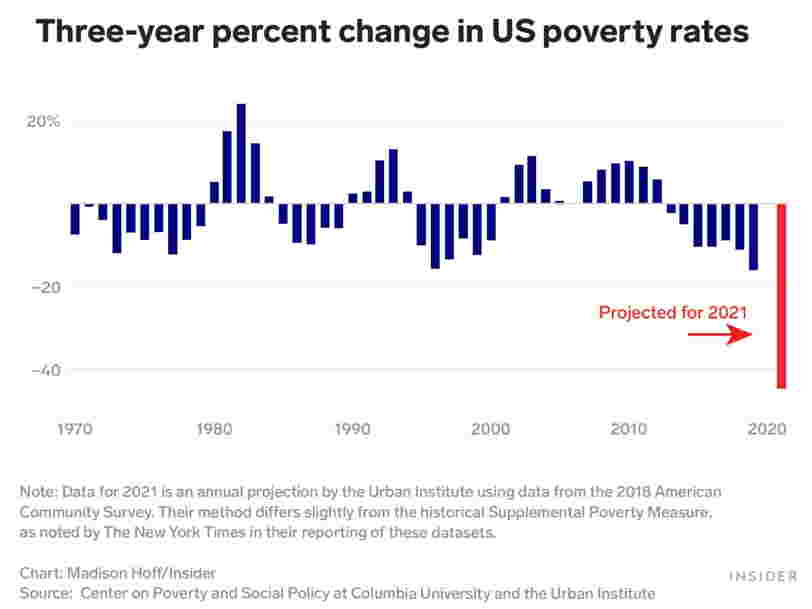One mind-boggling chart shows how government stimulus cut poverty by nearly half during the pandemic
Joseph Zeballos-Roig,Madison Hoff | Publié le
- New projections from the Urban Institute find the poverty rate will drop to 7.7% in 2021.
- The New York Times reported that would be a decline of about 45% from 2018.
- Researchers credited stimulus checks, federal unemployment benefits, and bulked-up food stamps.
- See more stories on Insider's business page .
The federal government embarked on a $6 trillion spending spree to keep individuals, businesses, and state governments afloat during the coronavirus pandemic - and it seems to have succeeded in lifting a lot of people out of poverty.
Much of that cash led to the biggest expansion of the social safety net in generations, helping people keep food on the table and make rent payments.
New research from the Urban Institute shows how the emergency relief programs led to one of the biggest major reductions in poverty.
Their analysis finds that without government programs such as stimulus checks and enhanced unemployment insurance, the poverty rate this year would be 23.1%. But these programs caused it to drop to a much lower 7.7% instead. Around 20 million fewer Americans in poverty now compared to 2018.
The Urban Institute's projection represents a 45% decline from previous levels in 2018. That would make it the largest drop in poverty on record, per the New York Times.
This can be seen by looking at changes in rates from one year compared to three years earlier. The following chart, as replicated from The New York Times' reporting of the historical Supplemental Poverty Measure poverty rates and Urban Institute's projected rate, highlights the percent change in rates from three years prior.
Three-year percent changes have varied over time and have mainly seen declines in the 2010s. But if the Urban Institute's projection is correct, it would mean the biggest drop in poverty rates from three years earlier, as seen in the chart.
Aid during the pandemic has given some Americans much needed assistance to get out of poverty. As Insider's Juliana Kaplan reported, poverty rates fell from December 2020 to January 2021 in part because of stimulus checks and federal unemployment benefits.
Stimulus checks lifted 12 million people out of poverty
Americans used the no-strings-attached checks from the government to pay off debt and cover expenses, and it also seems to play a big role in cutting the poverty rate.
"The federal stimulus checks have a larger antipoverty impact than any of the other programs; if all other programs were in place but the stimulus checks had not been paid, we project 12.4 million more people would be in poverty in 2021," the Urban Institute researchers wrote based on the programs used in their projections.
Programs helped Black Americans the most
The projected poverty rates from the new report for 2021 further vary by race and ethnicity, where the rate for non-Hispanic white Americans is 5.8% and 11.8% for Hispanic Americans. The researchers write that the government programs and benefits have the largest impact on non-Hispanic Black Americans. Without these programs, the projected rate for non-Hispanic Black Americans is 36.0%, but with these programs it is reduced to 9.2%.
Many of these programs ended or are set to expire
Many economists credit the stimulus payments and federal unemployment benefits with playing a major role powering the nation's recovery from the pandemic. The nonpartisan Congressional Budget Office forecasted last month the US would undergo its fastest pace of growth this year since the Reagan administration.
However, the end of these programs are nearing and its unclear whether Democrats will renew them given they were designed as pandemic relief.
Twenty-six states - mostly Republican-led - have already ended $300 weekly federal unemployment benefits for laid-off workers in an effort to encourage more people to head back to work. Early research suggests hiring hasn't picked up in many of those states.
People have largely spent their $1,400 stimulus payments from March, and enhanced unemployment insurance will expire just over a month from now. That's in addition to the end of the temporary 15% increase to food stamp benefits that were part of the stimulus law - those expire on Sept. 30.
Via PakApNews